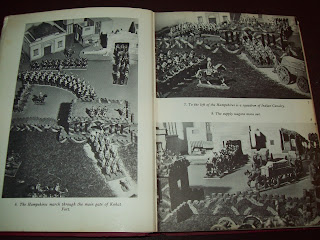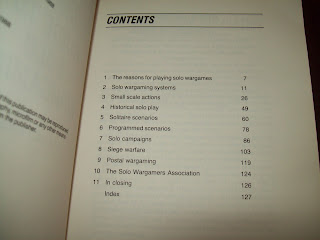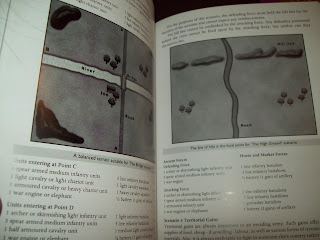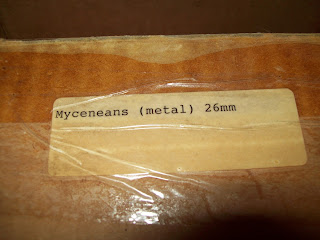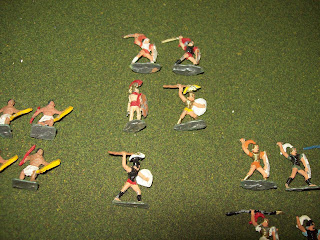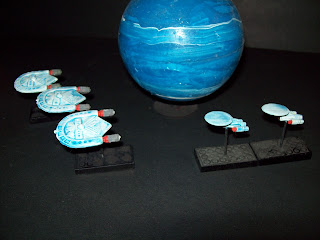Solo wargaming has always been the poor cousin of the hobby. Without a doubt, all wargamers have at some point played out scenarios by themselves to test rules or just pass the time. As far as the literature is concerned, there have been precious few titles dedicated to solo wargames.
The first is Donald Featherstone's "Solo Wargaming", Kaye & Ward, 1973, ISBN 0 7182 0921 4.
Featherstone was the established expert on miniature wargames and by the time this book was published, he had written at least 15 other titles. It is evident from the first sentence that solo wargaming was looked down on by the regular wargaming crowd:
"When one first considers solo wargaming it might first appear to be the inadequate last resort of the enthusiastic wargamer who desires to battle with model soldiers but cannot find a local opponent to face him across the table top battlefield."
The index shows that the book offers ideas on several aspects of solo games, from actual rules to campaigns that generate battles.
His chapters suggest "Instant" games, by dividing the table into sections and dicing for where units will be placed. The units will be represented at first by cards, with several blank cards added as well, and the identity of the units will be revealed once they move into contact with the enemy.
He suggests "Domestic Wargaming", where the player focuses on the level of brigade games, and ignores the grand strategy. Decisions are local, tactical in nature "so firmly in the hands of the one man who happens to be in charge on the spot at the time that his power is almost God like."
This is obviously one of his favorite aspects, and he illustrates the chapter with an attractive set of photos of his North West Frontier forces in front of a Marx fortress:
He continues by setting out the company organization of the units, including naming the Captains. He adds in a hand drawn map of the Kohat area. He also provides an narrative and suggests referring to his past publications to cover supply rules and adds chance cards to affect conditions and situations.
His chapter "Press Gangs" suggests using your wife or girlfriend as an opponent:
"There are at least half a dozen wargamers of the author's acquaintance who have fought wargames with their wives and some of them have actually lost to the "little woman"!"
Cringeworthy, but he goes on to suggest that newbies to the game would add unforeseen and unexpected decisions that would add much to a campaign or game.
Featherstone's chapter 'Realism Through Continuous Combat" suggests passing initiative between sides when ever a unit attacks. He then suggests using coloured chips to illustrate the tactical manoeuvers of a unit, such as firing, lying down, running, crawling, kneeling, dismount/mount cavalry, limber,unlimber guns, loading. Again this is a continuation of "Domestic Wargaming" with the focus on small unit tactics.He then adds four pages of rules from Jack Scruby. The chapter is illustrated by nine pages of a battle with Pathans at Kohat:
Two short chapters follow, "Concealment in Solo Wargames" and "Personalized Wargaming"
Chapter 8 is "Solo Wargaming in The New World". There are two sets of rules offered, and a write up about Jack Scruby. Scruby says of one set of rules:
"From my own experience in playing these rules (both with Schu and Vern Longlee) I can personally testify that this is the fastest, most exciting game I have known."
The games are of the "bang you're dead" type, and they are fun. However, the casualty results make references to unit structures that aren't explained, so you will have to make your own amendments. The second set offers part of a set, that has a determined kill ratio based on a dice roll. Units are 6 men strong, so a 5 or 6 rolled on a dice means that 6 men would kill 3 enemy. Less than 6 men would kill 2 enemy. A dice roll of 3 or 4 means that 6 men kill 2, less than 6 kill 1, a dice roll of 1 or 2 means 6 men would kill 1 less than 6 men would kill no enemy. Also in the chapter are some suggestions for messengers and scouts, including their reports or interrogation. These last rules aren't really fleshed out.
The 9th chapter has John Schuster's "Solo Musket Wargame" rules. These are not really rules so much as a suggested way to organize smallish armies and use dice to determine the strategy to create games.
"Solo Wargame Campaigns" is the 10th chapter that has at least one interesting suggestion, that map skirmishes can be played out by the solo gamer as a real battle. A squadron clash can be wargamed as a large cavalry battle by reducing the scale for the battle, and using as many as 300 miniature cavalrymen of all types in the game. The result is just that of a skirmish, but a fascinating and exciting game can result.
The next chapters are relatively short, and cover his oft mentioned "Matchbox System", "War Diaries", "Chance Cards", "Tactical Cards", "Regimental Cards".
Some of the last chapters are "A Small Spark of Courage" that gives general suggestions for a World War 2 tank "potted campaign", "More Books on Solo Wargaming", and "Battles by Mail".
Featherstone's chapter "Weather in Wargames" is a longer chapter, and has several tables and detailed effects of different types of weather.
"Wargaming in Bed" is a simple set of rules for jousting knights.
The 21st Chapter is "A Prince Of Solo Wargamers" is about Lionel Tarr. Tarr's rules for World War 2 were published in "Wargames" by Featherstone. What is covered is a general "how to" he set up his games, with maps, artillery fire by map grids, aircraft use, and periscopes for vision. It is an interesting insight to Lionel Tarr, whose few photos of his Stalingrad game have appeared in earlier Featherstone titles.
The book ends with a discussion of realistic terrain illustrated by pictures of Peter Gilder's Waterloo terrain.
He offers several Appendices at the end, perhaps the most useful being an annotated index of where one can find certain subjects in his other books.
On the whole, this is not that useful a book for the solo gamer.
It has very short suggestions from many different sources, all of which need fleshing out by the reader. There aren't any solid suggestions that you can lift and use in their entirety. The attitude that wargamers are all individuals who will make their own rules preclude this. As a book, it is attractive with a lot of photos of Don's toy soldiers in black and white. Currently it is out of print, and since his passing, the book has risen in value.
Amazon.com sometimes has copies as do ebay and Abebooks. The price varies from $20 to over $200.
The next book to consider is Stuart Asquith's "Guide To Solo Wargaming", a Military Modelling Publication, Argus Books, 1989, ISBN 0 85242934 7.
This title reflects a newer attitude to solo wargamers. Where Don Featherstone looked at Solo games as the poor cousin, Asquith says:
"While there are many wargamers who belong to clubs, there is at least an equal number who either prefer not to join a club or do not have access to one. For both these types of player it is modestly suggested that solo wargaming will succeed in filling a gap in the hobby for them. There are many advantages to being a solo wargamer and I hope that this book will cover most of them."
This is a more positive point of view of solo games. Asquith's second chapter is "Solo Wargaming Systems", and he wastes no time and gets right to it. He discusses Chance cards, Strategic and Tactical movement, dice use for probability, random terrain generation, random unit placement, off table arrivals, and re-supply.
The third chapter offers the basis for some historical small scale scenarios, such as a 14th century Free Company skirmish, an Indian Raid in the New World, a Russian 1812 retreat scenario, an attack on an Afghan fort, and an 1870 franc-tireurs game.
The fourth chapter moves up in scale from skirmishes to aspects of larger battles. First is the storming of the fleches and Grand Redoubt at Borodino, and then a 1915 Suvla Bay game.
The fifth Chapter has 8 scenarios and maps for the reader to game. Units are specified, the only thing missing are the rules to use to decide the combat.
Chapter 6 refers to his co-authored book with Charles S. Grant, "Programmed Wargames" (Wargames Research Group, 1983). A selection of map sectors, and programmed orders and order of battle for both Red/Blue armies are provided.
The 7th chapter is 15 pages on Solo Campaigns. Asquith discusses map movement, using overlays on a master map, and deciding contacts, battles and sieges on the map. He discusses the use of ammunition and food supply and suggests basic methods to cover this. Weather and casualties are touched upon at the end of the chapter.
The last Chapters are a 15 page one on Sieges, and one about postal wargames and another that mentions the Solo Wargames Association.
The author closes with the following:
"I hope this book has achieved its purpose in encouraging the reader to consider solo play as a very real wargaming option. The permutations on the various suggested games mechanisms are virtually endless, a fact that ensures the solo player can surely never tire of the hobby."
My own opinion is that this book is an overlooked gem. It was released as a part of a series of soft cover books by Military Modelling, and Stuart Asquith's other books in this series include: "Guide To Wargaming" and "Guide To Seige Wargaming". His wargaming book has simple, workable rules for many periods, and dovetail well with this solo wargaming book. The photos throughout are black and white, and many were seen in "Practical Wargaming" magazine, edited by Stuart Asquith.
This was only the second book on solo wargames, and it built solidly on the start Featherstone laid down in 1970.
It is regularly available on ebay, Amazon and abebooks. The price is affordable.
The Third book is one I found on Amazon. "The Solo Wargaming Guide" by William Sylvester, Precis Intermedia, 2013, ISBN 978-1-938270-13-0.
This soft cover book is about solo campaigns. The first sentence is;
"Rather than being a set of rules, this guide details and expands upon the various options available to solo wargamers. The aim of this book is to provide a solid, easily readable, easily understandable, and enjoyable guide for solo wargame campaigns. Novices and veterans alike can find new ideas and innovations in this book, and expand the excitement and enjoyment of the hobby."
Certainly a workmanlike declaration, and a real contrast to Featherstone's original book.
The author starts out immediately with the declaration of a need for a map. Either one created or borrowed from a board wargame. He suggests movement rates for a hexagonal grid, as well as the hours in a day per season. Sylvester uses the "Solo Campaign Mobilization Rules" or SCMR to raise armies, set out three attack plans and three defence plans, and gives tables to randomly determine mobilization speed and reaction, and determine Command Competency Rating (CCR). He uses his own campaign to provide examples throughout.
He gives a short chapter to discuss transpositioning time scales so that troops can be added to table top battles from the strategic hex map.
A weather table is provided and some detailed logistics and attrition rules are laid out. The author discusses morale, Alliances, Revolts and Sieges, as well as mutinies. All that in the first chapter of the book!
The second chapter covers naval campaigns..
Chapter 3 is about the personal aspect of campaigning and the positive effect of investing interest into the details of the game.
The 4th chapter covers fantasy campaigns.
The fifth chapter offers a sample campaign and map of the author's "First Aurunci War".
The rest of the book offers short sections and rules that cover Tactical gaming and solo playing scenarios to test rules and scenarios:
"Put simply, the solo gamer tries to not only simulate a certain period in history, whether a factual recreation or fictional simulation, but also simulate a dual-action game without the sometimes-dubious benefits of a second gamer."
Certainly a different attitude towards solo games in 2013 than in 1970.
Continuing with the contents covered, there is terrain and placement, more weather rules, Commander Competency and loss, battles, concealment, stragglers, and ambushes. The last two chapters are Air Wargames and Board Wargames.
Throughout this concise book, the author adds his own opinions and comments in quotes, in a very conversational style. What you end up with is a very useable book that can be picked up and immediately used by anyone to solo campaign with their own set of wargame rules.
I purchased my copy on Amazon. Reasonable prices.
So there it is, the three main book son solo wargaming that I have. Truth be told I also have the Partizan Press 2006 book by Stuart Asquith, "Guide To Solo Wargaming",but I forgot to include it while taking photos. I'll have to do an addendum..
As for the books, The Featherstone book is a classic, it is full of great photos of his toys and is worth having on your shelf even if just to pore over on a quiet evening.
The Stuart Asquith book is very useable, but is more focused on table top scenario generation. A great book for fast scenario creation by copying his style.
The William Sylvester book is the most workman like and useable as a campaign Bible. There are hard and fast rules that are simple but workable and with enough detail to keep interest and still create table top battles.
All three books don't offer a complete set of wargame rules or suggest a particular set.
***EDIT***
I missed out on Stuart Asquith's other book on solo gaming, "The Partizan Press Guide To Solo Gaming, A Revised Guide".
The author's foreword explains the rationale for the book;
"No lesser person than the genial but very business wise Dave Ryan, he of Partizan Press and Caliver Books fame, began asking me to consider rewriting and reworking the book back in the mid 1990's, but the essential "spark" was not there at the time. Undeterred and knowing that I was now retired, moved away from the big city, and rested, Dave resumed his campaign in 2005 and this book is the end result. I have altered and reworked much of the text and that there are some changes to the scenarios."
The main difference in the editions is the addition of a chapter called " Larger Battles". Running to 10 pages, it features maps, orders of battles, all in a very familiar format to those who have read the Asquith and Grant books on scenarios.
The book has a couple of sections of colour photos, and there are many black and white photos throughout.
As for the price, as with Caliver Book items, the book will range above $25. Amazon has several copies in the hundreds of dollars price range. On Matters Military was where I found my copy for $32.



















